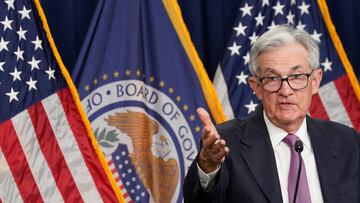When could the Fed raise interest rates again after pausing in June?
After a pause in the raising of interest rates by the Federal Reserve, could the central bank begin to increase them once again?


When announcing on Wednesday that the Federal Reserve would not increase interest rates in June, Chair Jerome Powell made clear that the pause was not likely to be permanent.
Chair Powell explained that by raising interest rates at such a rapid rate, the Fed had “covered a lot of ground” but added that “the full effects of our tightening have yet to be felt.” To account for the lagging effects, the Free Open Market Committee (FOMC) decided to pause any further rate hikes but noted that “nearly all Committee participants view it as likely that some further rate increases will be appropriate this year.”
Fed projects higher rates will be needed this year
In addition to these comments, the FOMC’s projections which were also released on Wednesday, provide greater detail as to what the central bank’s plans are. The projections released in March reported that 2023 the median for the Federal Funds Rate (FFR) in 2023 would be 5.1 percent. The June documents predict that the median for this year will be 5.6 percent. Currently, the FFR is hovering around 5.06 percent, meaning that the Fed would need to increase it by at least fifty-four basis points or .55 percent.
When will the FOMC meet next?
The next meeting of the FOMC is scheduled for 25-26 July. To hit the 5.6 percent median projected this month, the Fed will likely agree to another rate hike at that meeting. Between now and then, the Bureau of Labor Statistics and the Bureau of Economic Analysis will release a series of reports to inform the FOMC, including the June Employment Situation, the June Consumer Price Index report, and the May Personal Consumption Expenditure report.
The FOMC remains focused on the labor market.
Related stories
Chair Powell also mentioned that the Committee sees signs that labor market conditions are softening and adjusted their projection for the median unemployment rate for 2023, down from 4.6 to 4.1 percent. This is a positive sign, and hopefully, the lagging effects of interest rate hikes do not increase unemployment far beyond this figure. The Fed’s dual mandate is to ensure price stability and to create conditions for full employment. Officials at the Fed have associated the current inflationary crisis with increases in nominal wages, but the current drivers of inflation do not point towards higher wages as a continued motivator of inflation.
Nominal wage growth has shown signs of easing, and job vacancies have declined so far this year. While the jobs-to-workers gap has declined, labor demand still substantially exceeds the supply of available workers. FOMC participants expect supply and demand conditions in the labor market to come into better balance over time, easing upward pressures on inflation.
Jerome Powell, Chair of the Federal Reserve
Chair Powell argued that “labor demand still substantially exceeds the supply of available workers,” and since the Fed cannot create policies to increase the number of workers (i.e., increasing work permits and visas), their objective is that a higher interest rate environment will slow down the economy to the point where businesses need fewer workers or find growing their workforce too costly. Anyone who says that such action is as simple as a few calculations are oblivious to the complexities that exist with the US economy and the diverse impacts higher rates will have on different businesses of various sizes and industries.

